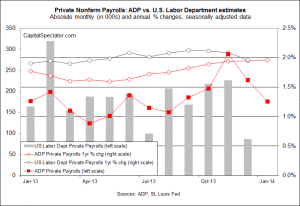Private payrolls increased by 175,000 last month (down from December’s 227,000 gain), according to this morning’s ADP Employment Report. That’s in line with the consensus forecasts from economists, although the advance is well below The Capital Spectator’s median econometric projection. (As a side note, today’s ADP number matched one of the forecasts that are used in CS’s median forecast: the triangular distribution prediction. The accuracy here isn’t unusual. I’ll have more to say about the intriguing possibilities for superior forecasting via triangular distributions in the days ahead. For now, let’s focus on the ADP data.)
It’s tempting to see today’s deceleration in the pace of growth for private payrolls as a sign of trouble for the economy, but that’s still a premature analysis. Why? Because when we look past the monthly changes, which can be volatile and therefore misleading, it’s clear that private payrolls continue to rise at roughly a 2% year-over-year rate—in line with recent history. In short, it’s not obvious that anything’s changed for the employment picture, despite what the latest monthly comparison implies.
That’s not the same thing as saying that there are no risks for the macro outlook. Indeed, there are a few more concerns at the moment vs., say, a month ago. But it’s critical to analyze the data in proper context with minimal subjectivity. That’s challenging under the best of circumstances; it’s even tougher in a period when the business cycle is facing new turbulence, which may describe the current climate.
Nonetheless, it’s worth repeating that high-confidence signals that the macro trend is genuinely deteriorating can’t be rushed. I’ve studied US economic history extensively in recent years and the vintage data (i.e., before revisions) is quite clear: new recessions are only conspicuous in a convincing degree shortly after they’ve started, perhaps as early as 2 to 3 months. A lot of people disagree and claim that they can see new recessions in advance—before there’s a sufficiently large set of confirming data to review. I’d like to see the evidence in support of such powers of prognostication.
In any case, we’re still nowhere near a potent case for arguing that the economy has suffered a sustained turn for the worse. Moderate growth is still the prevailing force, based on a diversified set of economic and financial indicators. Yes, this can change, and perhaps quickly, which is why I run fresh numbers regularly throughout each week.
Meantime, the case for anticipating moderate growth overall continues to draw support from a broad set of indicators, and today’s ADP update doesn’t alter this analysis. We’ll know more when we see tomorrow’s jobless claims data, Friday’s payrolls report from the government, and next week’s update on industrial production.
Yes, clarity is coming, for good or ill, but at the usual pace: one data point at a time.

Pingback: Wednesday links: after-tax returns | Abnormal Returns
Pingback: ADP: Slower Growth For Payrolls In January » The Capital Spectator